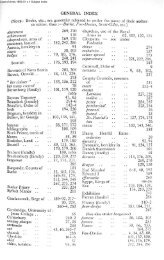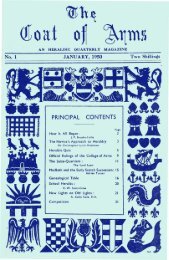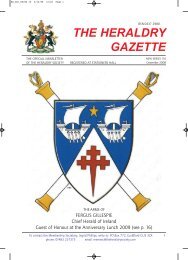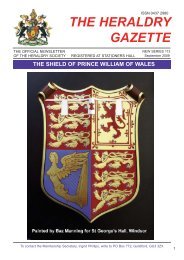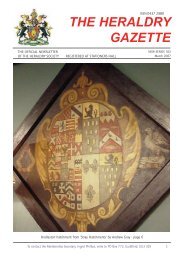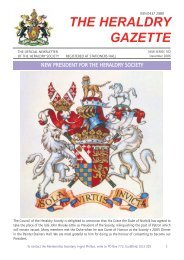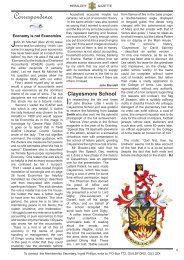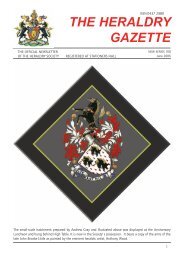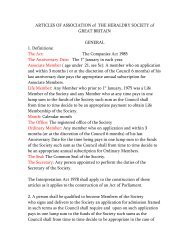You also want an ePaper? Increase the reach of your titles
YUMPU automatically turns print PDFs into web optimized ePapers that Google loves.
ISSN 0437 2980<br />
THE HERALDRY<br />
GAZETTE<br />
THE OFFICIAL NEWSLETTER<br />
OF THE HERALDRY SOCIETY REGISTERED AT STATIONERS HALL<br />
HRH THE DUCHESS OF CORNWALL<br />
NEW SERIES 97<br />
<strong>Sep</strong>tember 20<strong>05</strong><br />
reproduced with permission<br />
<strong>The</strong> Duchess of Cornwall has been granted armorial bearings which reflect her position as<br />
consort to <strong>The</strong> Prince of Wales. <strong>The</strong> arms follow ample precedent in marshalling elements from<br />
the achievement of <strong>The</strong> Prince of Wales to the dexter and those relating to his wife’s family to<br />
the sinister. <strong>The</strong> shield is ensigned by the single arched coronet and supported by the dexter<br />
supporter of the Heir Apparent.<br />
<strong>The</strong> arms to the sinister are derived from the arms recorded for Major Bruce Shand, the<br />
Duchess’s father, except that a minor difference appears to have been made in the shield’s<br />
principal charge, the boar’s head depicted as erased rather than couped. Major Shand’s crest<br />
is ‘a boar statant Azure armed and langued Gules his dexter forefoot resting on a mullet Gules’<br />
and the blue boar gorged with a royal coronet and chained appears as the sinister supporter.<br />
See the note ‘Shand Family’ on page 8.<br />
To contact the Membership Secretary, Ingrid Phillips, write to PO Box 772, Guildford, GU3 3ZX<br />
1
2<br />
CRANWELL HERALDRY<br />
PART ONE: THE ROYAL AIR FORCE BADGE<br />
Ceremonial Gates Cranwell Avenue Portico<br />
With the recent painting of the wrought-iron<br />
gates, and the re-gilding of the badges which<br />
adorn them, the Ceremonial Entrance to the<br />
Royal Air Force College has been restored to a<br />
state in which it would have been seen when<br />
College Hall was officially opened in 1934. By<br />
then the College had its own coat of arms but<br />
it was the badge of the Royal Air Force which<br />
was chosen for the gates, and the Cranwell<br />
version is made all the more impressive by the<br />
‘oversized’ eagle that flies out from the circlet<br />
and crown, which together complete the<br />
design.<br />
<strong>The</strong> Royal Air Force badge came into use in<br />
August 1918, when the circlet took the form of<br />
a garter and buckle. But in heraldry, this<br />
proved to be incorrect and it was replaced by a<br />
plain circlet when the badge was registered at<br />
the College of Arms on 26 January 1923.<br />
During the reigns of George V, Edward VIII<br />
and George VI the Tudor Crown had<br />
surmounted the circlet. But it seems that the<br />
crown, the circlet and the eagle were subject to<br />
a wide range of variations with regard to style,<br />
composition and proportion, and it was not until<br />
1949 that the design was standardised. From<br />
that date, the ‘oversized’ eagles, which<br />
dominate the badges on the gates of the<br />
College, gave way to a smaller version that<br />
dissects the circlet; in the form seen on the<br />
porticos, erected on Cranwell Avenue in 1997.<br />
<strong>The</strong> description of the Royal Air Force badge<br />
was promulgated in Air Ministry Orders<br />
A.666/49, which were published on 15<br />
<strong>Sep</strong>tember 1949, and it reads: “In front of a<br />
circle inscribed with the motto, ‘Per Ardua Ad<br />
Astra’, and ensigned with the Imperial Crown,<br />
an eagle volant and affronté, the head lowered<br />
and to the sinister”.<br />
By choosing the motto of the Royal Flying<br />
Corps and the emblem of the Royal Naval Air<br />
Service, it seems that the Air Council’s original<br />
intention was to demonstrate a clear lineage<br />
for the Royal Air Force; and yet these<br />
elements of the new badge have long given<br />
rise to conjecture and debate.<br />
<strong>The</strong> most persistent debate is to do with the<br />
emblem, which is supposed by some to be an<br />
albatross, because of its association with the<br />
Royal Naval Air Service. But it is precisely<br />
because of its association with the Royal<br />
Naval Air Service that the emblem is an eagle.<br />
In his book ‘Airmen or Noahs’, published by<br />
Pitman in 1928, Rear-Admiral Murray Sueter<br />
attributed the choice of the Royal Naval Air<br />
Service emblem to an item of jewellery owned<br />
by his wife. In a footnote he states, “Mr<br />
Winston Churchill wanted an eagle for a<br />
badge to be worn on the sleeve of the coat to<br />
distinguish the naval airmen. An artist was<br />
sent for and he produced a design like a<br />
goose. But Mrs Sueter had a gold eagle<br />
Items for inclusion in the Gazette post to: <strong>The</strong> Editor, <strong>The</strong> <strong>Heraldry</strong> Gazette, at the<br />
address given on page 10, or e-mail to: gazette@theheraldrysociety.com
ooch of French Imperial design that she had<br />
purchased in Paris. I took this eagle brooch to<br />
the Admiralty to show Mr Churchill and Admiral<br />
Prince Louis of Battenberg. <strong>The</strong>y much<br />
preferred it to the goose design of the artist and<br />
adopted it for the badge of the Royal Naval Air<br />
Service.”<br />
<strong>The</strong> Royal Naval Air Service came into being<br />
on 1 July 1914, and the initial dress regulations<br />
were promulgated in Admiralty Weekly Order<br />
No 2, where there is a first official reference to<br />
the emblem of the navy’s new air arm: “<strong>The</strong><br />
badge of an eagle will be worn by members of<br />
the Royal Naval Air Service at the top left<br />
sleeve”. Later, when it was felt that aircrew<br />
should be further differentiated, Admiralty<br />
Weekly Order 756/16, of 21 April 1916, stated<br />
that in addition to the eagle on the left sleeve a<br />
further eagle should be worn on the left<br />
shoulder strap. <strong>The</strong>n, on 8 June 1917, in<br />
Admiralty Weekly Order 2106/17, aircrew were<br />
required to wear the eagle on both sleeves and<br />
both shoulder straps.<br />
With so many references to the eagle, there<br />
can be no doubt as to its use by the Royal<br />
Naval Air Service, or to its subsequent use by<br />
the newly-formed Royal Air Force, which<br />
adopted the rank badges of the Royal Naval Air<br />
Service and the rank titles of the Royal Flying<br />
Corps. As such, a lieutenant colonel wore<br />
“three rows of distinguishing lace surmounted<br />
by bird (sic) and crown”, the latter being similar<br />
to the badge on an officer’s field service cap of<br />
today. It was not until 27 August 1919 that an<br />
Air Council Order replaced army titles of rank<br />
with Royal Air Force titles of rank, and<br />
consigned the ‘bird and crown’ device from the<br />
sleeve to the shoulder strap.<br />
Having used Admiralty Orders to establish<br />
that the Royal Naval Air Service emblem was<br />
an eagle, and Air Ministry Orders to confirm<br />
that the eagle had been adopted by the Royal<br />
Air Force, it would seem that these same<br />
orders could be used to reveal the genesis of<br />
the albatross debate. From 1 April 1918, the<br />
Royal Air Force undertook all Service flying<br />
training, and detached some of its air and<br />
ground crews for service with the Royal Navy.<br />
In April 1924 these detachments were<br />
designated the Fleet Air Arm of the Royal Air<br />
Force. Soon afterwards, naval officers began<br />
to train as pilots with the Royal Air Force, and<br />
they then joined its fleet air arm: but the<br />
Admiralty decided to award its own flying<br />
badge. So, when Admiralty Fleet Order No<br />
2793 was issued, on 2 October 1925, it<br />
described the new badge for navy pilots as: “A<br />
silver anchor and cable of silver embroidery<br />
surrounded by a laurel wreath of silver<br />
embroidery superimposed on the wings of an<br />
albatross”.<br />
So, with the albatross attributed to the Royal<br />
Navy of 1925, and the eagle established as the<br />
emblem of the Royal Air Force from 1918,<br />
attention now turns to the motto which is<br />
inscribed on the circlet.<br />
Having been approved by George V, ‘Per<br />
Ardua Ad Astra’ was promulgated as the motto<br />
for the Royal Flying Corps in Army Order No 3,<br />
on 15 March 1913. <strong>The</strong> motto had been<br />
suggested by Lieutenant J S Yule, of the Royal<br />
Engineers, who discovered the words in Sir<br />
Henry Rider Haggard’s novel ‘<strong>The</strong> People of<br />
the Mist’. In the first chapter there is a<br />
description of “two stone pillars on whose<br />
summit stood griffins of black marble<br />
embracing coats of arms and banners<br />
inscribed with the device Per Ardua Ad Astra”.<br />
According to Group Captain A H Stradling in<br />
his ‘Customs of the Services’, published by<br />
Gale and Polden in 1966, Rider Haggard’s<br />
source was the Irish family of Mulvany, whose<br />
motto it had been for centuries. But its<br />
meaning was in dispute. According to<br />
Squadron Leader P G Herring, in his ‘Customs<br />
and Traditions of the Royal Air Force’,<br />
published by Gale and Polden in 1961, the<br />
Mulvany family understood the meaning of the<br />
motto to be “Through Difficulties to the Skies”,<br />
whilst Rider Haggard believed it to be “Through<br />
Struggle to the Stars”. Seeking literal meaning<br />
of the motto, the Air Ministry approached the<br />
College of Arms, who declared that no<br />
authoritative translation was possible. So in<br />
the words of a contemporary postscript by the<br />
Air Council Member for Personnel, “Let<br />
everyone translate it as they think fit”.<br />
Group Captain P J Rodgers MBE FRAeS<br />
RAF (Retd)<br />
Items for inclusion in the Gazette: post to the Editor, <strong>The</strong> <strong>Heraldry</strong> Gazette, at the address<br />
given on page 10 or by e-mail to gazette@theheraldrysociety.com<br />
3
4<br />
THE HIGH SHERIFFS OF OXFORDSHIRE - PART ONE<br />
Martin Davies's recent appeal for information<br />
about court room heraldry made me dig in my<br />
files. He is quite right that photography is a<br />
problem in any court building as it is feared that<br />
photos may fall into the hands of violent<br />
criminals who then use them to plan their gang<br />
members' break out while on trial. Indeed,<br />
even access by the general public is<br />
sometimes difficult for similar reasons. Without<br />
good cause to be there it may be impossible to<br />
gain entry to certain court buildings. Whereas<br />
they were seen as prime targets for IRA<br />
terrorism for 30 years, that fear has now been<br />
supplanted by one of more global origins.<br />
As well as the depictions of current royal<br />
arms, certain courts display the arms of High<br />
Sheriffs or Lords Lieutenant of their county in<br />
an ante room. When I was approached by<br />
John Brooke-Little some years ago to produce<br />
a shield for the upcoming High Sheriff of<br />
Oxfordshire I was given the signal honour of<br />
being allowed to take a camera into the Oxford<br />
Crown Court, albeit carefully chaperoned, to<br />
John Thomson 1957<br />
Ermine an eagle displayed<br />
Sable charged on the breast<br />
and each wing with an<br />
escallop Or on a chief Gold a<br />
rose Gules barbed and<br />
seeded proper between two<br />
bulls' heads cabossed also<br />
Gules.<br />
<strong>The</strong> first shield in the series.<br />
This was painted many years<br />
later as Spurrier was only a<br />
schoolboy in 1957. It is a<br />
good example of his skill as<br />
an artist with well drawn<br />
charges, nicely balanced and<br />
filling their space. Strangely,<br />
he varnished the eagle and<br />
overlapped the varnish onto<br />
the white of the ermine field, a<br />
technique known as “pencil<br />
varnishing”. This is usually<br />
only done on glass to protect<br />
the artwork. Here the varnish<br />
has yellowed, inevitable over<br />
the years, and now shows up<br />
on the white.<br />
David Wills 1961<br />
Gules three estoiles of twelve<br />
points fesswise between two<br />
griffins passant Or beaked<br />
Azure that in chief charged<br />
with a crescent Gold on a<br />
mullet Gules for difference.<br />
(<strong>The</strong> stars are composed of<br />
alternating wavy and straight<br />
lines.)<br />
record the existing shields. <strong>The</strong>re are now<br />
some 33 adorning the walls of this large room<br />
where witnesses and appellants sit waiting for<br />
their turn in front of a judge. Most before 1998<br />
were done by that most accomplished heraldic<br />
artist and one time herald Peter Spurrier, who<br />
is no longer with us.<br />
<strong>The</strong> arms on the wall are not a complete<br />
record of the High Sheriffs. <strong>The</strong> shields have to<br />
be paid for by the office holder, no public funds<br />
ever being made available. In recent years all<br />
have elected to join in and it can be assumed<br />
that the gaps relate to those who did not. Nonarmigers<br />
can use the badge of office on a blue<br />
hexagon with their name and year below. This<br />
can be blazoned as, ''Two swords in saltire<br />
blades uppermost Argent pommels and hilts Or<br />
that in bend broken.''<br />
In this and the following part is a complete<br />
list of shields displayed up to the present<br />
incumbent of 20<strong>05</strong>. <strong>The</strong> post is held for one<br />
year starting in April. <strong>The</strong> names and dates are<br />
as written below each shield.<br />
Visit the website at www.theheraldrysociety.com<br />
J. Heyworth 1962<br />
Quarterly 1st & 4th: Argent six<br />
lions three two and one Sable;<br />
2nd & 3rd: Argent two<br />
barrulets wavy between three<br />
bats Sable.<br />
Alan Budgett 1965<br />
Azure on a cross invected<br />
between four water bougets<br />
Or an escallop between as<br />
many horseshoes of the field.<br />
Charles Radclyffe 1967<br />
Argent two bendlets engrailed<br />
Sable a label Gules.<br />
Miles Gosling 1970<br />
Gules on a chevron between<br />
three crescents Or a squirrel<br />
affronty cracking a nut<br />
between two like squirrels<br />
also cracking nuts respectant<br />
proper in chief a cinquefoil<br />
Gold. (<strong>The</strong> cinquefoil is an
oddity as it is in the position of<br />
a cadency mark, has been<br />
finely outlined to contrast<br />
against the boldly outlined<br />
crescents and yet has been<br />
drawn large enough to be a<br />
charge. <strong>The</strong> impression is that<br />
it should have been the<br />
double quatrefoil of a 9th son.<br />
As a charge it ruins the<br />
symmetry of the shield.<br />
Spurrier repeated this for<br />
Brunner of 1988, yet there is a<br />
correct cadency mark in this<br />
position for Parker of 1989<br />
also drawn quite large. Both<br />
can be viewed in part 2.)<br />
<strong>The</strong> 3 dainty squirrels of<br />
Gosling. Note the cinquefoil<br />
in chief.<br />
Peter Parker 1973<br />
Gules a chevron between<br />
three lions' heads affronty Or.<br />
W. Birch Reynardson 1974<br />
Quarterly 1st & 4th: Or two<br />
chevronels engrailed and in<br />
chief a rose Gules barbed and<br />
seeded proper on a canton<br />
also Gules a mascle Argent;<br />
2nd & 3rd Azure three fleursde-lis<br />
and a canton Argent.<br />
John Collins 1975<br />
Or on a pale Vert between two<br />
apples slipped and leaved<br />
proper three bezants on a<br />
chief also Vert as many<br />
anchors sans cables Gold.<br />
J. C. L. Fane 1977<br />
Azure three dexter close<br />
gauntlets Or.<br />
(This is the coat of the Earls of<br />
Westmorland who poetically<br />
blazon their charges as three<br />
dexter gauntlets backs<br />
affronty.)<br />
William Bell 1978<br />
Azure a chevron Ermine<br />
between in chief two bells and<br />
in base a fleam Or.<br />
<strong>The</strong> Hon. Charles Cecil 1979<br />
Barry of ten Argent and Azure<br />
six escutcheons three two and<br />
one Sable each charged with<br />
a lion rampant Argent in<br />
centre chief a crescent Argent<br />
on a like crescent Sable for<br />
difference.<br />
(<strong>The</strong>se are the unquartered<br />
arms of the Marquesses of<br />
Salisbury.)<br />
Robert Fleming 1980<br />
Per chevron Sable and Argent<br />
in chief two goats' heads<br />
erased Argent armed and<br />
holding in the mouth a lily<br />
slipped Or in base a cross<br />
flory Gules.<br />
Thomas Hall 1981<br />
Argent three talbots' heads<br />
erased Sable between five<br />
crosses crosslet Azure on a<br />
chief Sable an eastern crown<br />
Or. (How three charges can<br />
satisfactorily be portrayed<br />
between a different number of<br />
charges is a challenge to<br />
artists. Burke records similar<br />
shields for Halls with nine<br />
crosslets and five, as here,<br />
with no indication of their<br />
layout. It is a rare example of<br />
artistic licence being allowed<br />
to be exercised in heraldry,<br />
with numerous alternatives<br />
suggesting themselves. Here<br />
Spurrier has placed the<br />
crosses and heads evenly on<br />
the field which ends up with<br />
two crosses being obscured<br />
beneath the heads. This<br />
stretches the term 'between'<br />
to the limit.)<br />
<strong>The</strong> challenging arms of Hall<br />
as explained in the text<br />
Sir Mark Norman Bt 1983<br />
Sable a thunderbolt and in<br />
chief two crosses formy<br />
pierced with the eight symbols<br />
of Fhohe or the Pa-qua and<br />
charged with a roundel<br />
containing the eastern symbol<br />
known as Tae Keigh all Or in<br />
centre chief a baronet's<br />
badge. (I am grateful to<br />
Debrett for this impossible<br />
blazon. <strong>The</strong> first armiger's<br />
obvious eastern interests may<br />
have been connected to the I-<br />
Ching: the crosses are<br />
charged with trigrams and<br />
pierced with the yin-yang<br />
symbol.)<br />
Baz Manning SHA<br />
. . . to be continued<br />
E-mail the editor at gazette@theheraldrysociety.com 5
ALMANAC OF EVENTS OCTOBER TO DECEMBER 20<strong>05</strong><br />
Oct 1 Middlesex <strong>Heraldry</strong> of Bermuda Marjorie Kirby<br />
1 Manchester Ducal <strong>Heraldry</strong> Alan Fennely<br />
3 Lancashire <strong>Heraldry</strong> in East Anglia Gwyneth Hagen<br />
5 Norfolk Military Connections Iain Swinnerton<br />
7 <strong>Heraldry</strong> <strong>Society</strong> Visit to the College of Arms William Hunt<br />
15 Chilterns New Thoughts on Old Hatchments Andrew Gray<br />
15 Bath Nelson <strong>Heraldry</strong> Michael Furlong &<br />
Roland Symons<br />
19 <strong>Heraldry</strong> <strong>Society</strong> ‘<strong>The</strong> <strong>Heraldry</strong> of Trafalgar’ David White<br />
26 Yorkshire Duxbury Lecture Hugh Murray<br />
<strong>The</strong> Enamel Painters of York (1589-1792)<br />
26 Somerset Visit to St Cuthbert’s Church, Wells<br />
Nov 2 Norfolk <strong>The</strong> English Knights of St John Tony Sims<br />
5 Middlesex Cromwell’s Armorial Background Keith Lovell<br />
5 Manchester Welsh <strong>Heraldry</strong> Dorothy Lee-Fitchett<br />
7 Lancashire Royal Regalia Nigel Griffin<br />
12 Somerset Visit to North Cadbury Church and Court<br />
14 <strong>Heraldry</strong> <strong>Society</strong> <strong>The</strong> <strong>Society</strong> Dinner<br />
Principal Guest: <strong>The</strong> Earl Marshal<br />
19 Norfolk St Edmund’s Lunch<br />
19 Chilterns Afternoon with the Pierson Slide Collection John Titterton<br />
19 Bath Conserving the Records of the College Christopher Harvey<br />
of Arms<br />
23 <strong>Heraldry</strong> <strong>Society</strong> <strong>The</strong> Constance Egan Lecture Cecil Humphery-<br />
‘A Japanese Armorial’ Smith<br />
30 Manchester Manchester Town Hall<br />
30 Yorkshire <strong>Heraldry</strong> on the Right Lines Peter Marshall<br />
Dec 3 Manchester East Anglia <strong>Heraldry</strong> Gwynneth Hagen<br />
5 Lancashire Seasonal Fun Evening<br />
10 Bath Arcadian <strong>Heraldry</strong> Michael Messer<br />
13 <strong>Heraldry</strong> <strong>Society</strong> Annual General Meeting<br />
14 Yorkshire Mythical Beasts Jim Winstanley<br />
Please check details of meetings with the appropriate contact person shown on page 16 of the<br />
June issue.<br />
Please note that other heraldic events take place. This is not an exhaustive list. If you would like<br />
your events to appear please send details to: gazette@theheraldrysociety.com, including in the<br />
subject line - almanac entry.<br />
6<br />
Visit the website at www.theheraldrysociety.com<br />
AUTUMN DINNER<br />
20<strong>05</strong><br />
A reminder that bookings for<br />
the Autumn Dinner must be<br />
received by 31 October. As<br />
announced previously in the<br />
Gazette, our Patron the Duke<br />
of Norfolk is to be the Guest of<br />
Honour, and the splendid<br />
setting will be Painters' Hall. A<br />
booking form is enclosed with<br />
this issue for members with<br />
UK addresses.
THE 20<strong>05</strong>-2006 LECTURES AND VISITS PROGRAMME<br />
<strong>The</strong> over-arching theme for the 20<strong>05</strong>-2006<br />
lecture season is Recording <strong>Heraldry</strong>. This<br />
takes the Basic <strong>Heraldry</strong> module of the 2004-<br />
20<strong>05</strong> season a stage further and will give<br />
members an insight into British and foreign<br />
recording of heraldry.<br />
<strong>The</strong> sponsored lectures in the forthcoming<br />
season start with the Mark Elvins Lecture,<br />
traditionally on a religious theme: this will be on<br />
the impact of the Reformation on German<br />
heraldry. For the Constance Egan Lecture<br />
Cecil Humphery-Smith will talk on a Japanese<br />
Armorial. <strong>The</strong> John Brooke-Little lecture will be<br />
by Patrick Cracroft-Brennan on the stall plates<br />
of the Knights of the Garter. <strong>The</strong> final<br />
sponsored lecture, that of the Worshipful<br />
Company of Scriveners, will be given by the<br />
retiring Chairman of Council, Dr Malcolm Golin.<br />
This year being the 200th Anniversary of our<br />
greatest naval victory, Somerset Herald has<br />
kindly agreed to lecture in Trafalgar month on<br />
the heraldry of the victors of Trafalgar.<br />
NORFOLK HISTORY QUIZ<br />
Lectures are included in the annual<br />
subscription, but an informal retiring collection<br />
is made to help to defray the hire costs of the<br />
premises.<br />
Windsor Herald is kindly hosting an evening<br />
visit to the College of Arms and the Institute of<br />
Heraldic and Genealogical Studies is hosting a<br />
visit to Canterbury. <strong>The</strong> visit to St John's Gate<br />
was heavily over-subscribed last season so will<br />
be repeated early in 2006. <strong>The</strong>se visits are<br />
self-financing and tickets are available in<br />
advance from the Programme Secretary.<br />
<strong>The</strong> Programme Secretary would very much<br />
appreciate help in advertising the lectures to a<br />
wider public and is looking for an Assistant<br />
Programme Secretary to take over this aspect.<br />
If you feel you could spare time and would like<br />
to help the <strong>Society</strong> in this way, please contact<br />
the Programme Secretary, Colonel Michael<br />
Phillips, either on 01483 237375 or through the<br />
Membership Secretary on 01483 237373 or email<br />
memsec@theheraldrysociety.com.<br />
Can you answer the following questions:- * (see answers at the end of the article)<br />
1. Who is the patron Saint of Russia ?<br />
2. Who succeeded Genghis as the Great Khan ?<br />
3. Who was the British Prime Minister during most of the American War of Independence ?<br />
No? I am not surprised, but it was the ability to answer these and approximately 90 similar<br />
questions, some even more difficult, that enabled the Norfolk <strong>Heraldry</strong> <strong>Society</strong> once again to win<br />
the Norfolk History Quiz.<br />
<strong>The</strong> Quiz takes place every year and teams of not more than three members can take part. <strong>The</strong><br />
Norfolk <strong>Heraldry</strong> <strong>Society</strong> has won the Quiz 10 times in the last 15 years. A formidable<br />
achievement. This year the team consisted of Chairman Andy Anderson and John Dent,<br />
Hon.FHS, Founder Member and Vice-President of the <strong>Society</strong>. Although they had one member<br />
less than the permitted number of three per team, they were still able to fend off the considerable<br />
opposition provided by local teams from, among others, the Richard III <strong>Society</strong> and the<br />
Battlefields Trust.<br />
*1. St Andrew. 2. Ogadai, his third son 3. Lord North.<br />
PLEASE NOTE:<br />
<strong>The</strong> next deadline for<br />
contributions to the<br />
Gazette is<br />
1st November.<br />
Visit the website at www.theheraldrysociety.com 7
8<br />
CUHAGS PRESIDENT<br />
On 11th June the Cambridge<br />
University Heraldic and<br />
Genealogical <strong>Society</strong> installed<br />
its 20<strong>05</strong> President, Antti<br />
Matikkala. Previously President<br />
of the Finnish <strong>Heraldry</strong> <strong>Society</strong>,<br />
Antti is well know in <strong>Heraldry</strong><br />
<strong>Society</strong> circles since coming to<br />
Cambridge to pursue his postgraduate<br />
studies. <strong>The</strong><br />
installation took place at the<br />
customary Accession Banquet<br />
in Clare College. An impressive<br />
guest list included Lord Slynn of<br />
Hadley, H.E. the Ambassador of<br />
Finland, and a number of<br />
<strong>Heraldry</strong> <strong>Society</strong> luminaries. It<br />
was also encouraging to meet<br />
Michael Burtscher and Marshal Walker, who are endeavouring<br />
to resurrect the Oxford University society. We stand ready to<br />
give them any help they need in that enterprise. Our warm<br />
congratulations go to Antti, and we wish him every success in<br />
his year of office.<br />
Visit the website at www.theheraldrysociety.com<br />
SHAND FAMILY<br />
<strong>The</strong> Shands of Craig,<br />
Aberdeenshire became<br />
opulent in the 16th and 17th<br />
centuries. <strong>The</strong>re is a tradition<br />
that the Shands came to<br />
Aberdeenshire in the 14th<br />
century and it is possible that<br />
the boar's head indicates<br />
some feudal or similar<br />
connection with the Gordons<br />
whose ancient arms featured<br />
a single boar's head (current<br />
arms feature three). <strong>The</strong><br />
three mullets gules featured<br />
on the chief of the Shand of<br />
Craig arms probably came<br />
from marriage alliances with<br />
families which featured them.<br />
<strong>The</strong> difference adopted by the<br />
Lord Lyon in Major Shand's<br />
arms is the replacement of the<br />
centre mullet by a cross<br />
crosslet fitchy. MJ
PRINCE OF WALES’ ARMS AT POUNDBURY, DORSET<br />
To enhance the Brownsword Hall at<br />
Poundbury, the Duchy of Cornwall<br />
Development on the edge of Dorchester in<br />
Dorset, HRH Prince Charles asked me to paint<br />
a 3 feet square panel depicting his arms as<br />
Prince of Wales. This, together with excellent<br />
scenic and Duchy Arms wallhangings<br />
executed by Monica Perry, has just been hung<br />
in the hall for permanent exhibition.<br />
<strong>The</strong> most immediate spin-off from the<br />
commission has been copious requests for<br />
both technical and historical information on<br />
every detail of the Arms, resulting in talks and<br />
necessitating the creation of a leaflet. <strong>The</strong><br />
most unexpected question so far has come from<br />
a small boy at my talk to a local primary school:<br />
“Why wasn’t King James I and VI called King<br />
James VII?”<br />
Patrick Grove-White<br />
PERCY VANT Herald with a Difference by Peter Field<br />
<strong>The</strong> deadline for contributions to the next Gazette is 1st November 9
Crest of Bolton<br />
Alan Buckingham (June<br />
20<strong>05</strong> number of the Gazette)<br />
wrote about the connection<br />
between the elephant and<br />
castle devices of Bolton and<br />
Coventry. <strong>The</strong> first known<br />
depiction of this as Bolton's<br />
crest appears on Baines's<br />
map of the town dated 1824.<br />
<strong>The</strong>re are two versions of its<br />
adoption by the trustees of<br />
Great Bolton ; first that the<br />
'elite of Bolton adopted this<br />
splendid heraldic device in<br />
1799 at the suggestion of Pitt<br />
Hewitt', one of the original<br />
trustees and the other, that it<br />
was the suggeston of Ralph<br />
Boardman solicitor and clerk<br />
of the trustees, who had an<br />
old seal bearing the device.<br />
Bolton was incorporated in<br />
1838 and the borough<br />
continued to use this crest<br />
until 1890 when it was<br />
decided to apply for a grant of<br />
arms. <strong>The</strong> subscription list<br />
was opened in March and the<br />
letters patent were dated 5th<br />
June - such matters being<br />
effected more speedily than<br />
these days. Major Ottley Lane<br />
Perry, a former councillor was<br />
instrumental in the design and<br />
decided to commemorate<br />
Bolton's distant ecclesiastical<br />
link with Coventry by<br />
incorporating a mitre on the<br />
saddle cloth of the elephant.<br />
Incidentally is there any<br />
explanation of Coventry's<br />
elephant? Following the<br />
reorganisation of local<br />
government in 1974 the<br />
Metropolitan Borough of<br />
Bolton had a new grant of<br />
arms and the tenuous<br />
Coventry connection of the<br />
10<br />
CORRESPONDENCE<br />
mitre was replaced by the<br />
more appropriate Lancaster<br />
rose - see illustration in March<br />
20<strong>05</strong> number of the Gazette.<br />
Malcolm Howe Chelsea<br />
(formerly of Bolton)<br />
I refer to Alan Buckingham's<br />
letter in the June 20<strong>05</strong> edition<br />
of the Gazette and think he is<br />
right to be suspicious of<br />
Wilfrid Scott-Giles'<br />
explanation for the elephant<br />
and castle in Bolton's arms.<br />
That is also Bolton Council's<br />
official explanation and was<br />
adopted by H Ellis Tomlinson<br />
in 1974, but I believe it was<br />
the rationalisation of an<br />
heraldic enthusiast - excouncillor<br />
Major Otley Perry,<br />
who suggested the design for<br />
the County Borough Council<br />
in 1890 - for an existing use.<br />
Certainly there was already<br />
a connection between Bolton<br />
and the elephant and castle<br />
as early as 1831, when two<br />
coaches on Bolton's first<br />
railway were named<br />
'Elephant' and 'Castle'. A<br />
newspaper advertisement for<br />
a drapery business in 1838<br />
included a shield with two<br />
bends surmounted by an<br />
elephant and castle on a<br />
torse, but when the newlycreated<br />
Municipal Borough<br />
Council obtained its first seal<br />
in 1839, the elephant and<br />
castle, on a mound, were on<br />
the shield. From then until<br />
Please send your letters or articles to the Editor of<br />
the Gazette at the following address: <strong>The</strong> Head’s<br />
House, Fred Nicholson School, Westfield Road,<br />
Dereham, Norfolk NR19 1JB or by e-mail to<br />
gazette@theheraldrysociety.com<br />
Visit the website at www.theheraldrysociety.com<br />
1890 the Municipal Borough<br />
Council and then the County<br />
Borough Council used the<br />
elephant and castle in many<br />
different forms - on a shield,<br />
on a torse or as a free-floating<br />
object.<br />
In the discussions with the<br />
College of Arms in 1890 on<br />
the Council's application for a<br />
grant, the Council resolved<br />
that new arms should<br />
resemble as much as possible<br />
the device previously used<br />
and so the elephant and<br />
castle became the crest. On<br />
the creation of the<br />
Metropolitan Borough in 1974,<br />
the one feature of the old<br />
arms which council members<br />
insisted should be retained<br />
was the elephant and castle,<br />
so strong was its association<br />
with Bolton. My theory for that<br />
connection is that there was a<br />
representation of the elephant<br />
and castle in the mediaeval<br />
parish church since it was an<br />
important Christian symbol in<br />
view of the beneficent<br />
characteristics ascribed to it in<br />
the bestiaries, and that,<br />
therefore, it appears on the<br />
borough arms because of the<br />
strange sexual habits of<br />
mediaeval elephants.<br />
Incidentally, the elephant<br />
and castle borne on Fred<br />
Dibnah's coffin was borrowed<br />
from Bolton museum and is<br />
one of a pair of 19th century<br />
cast-iron elephants which
stood on the gate pillars of a<br />
bleachworks. It lay on the<br />
route to the Bolton Royal<br />
Infirmary and nervous children<br />
were distracted by being told<br />
that at midnight each New<br />
Year's Eve the elephants<br />
exchanged gateposts so that<br />
they had a slightly different<br />
view for the succeeding year.<br />
That's about as well<br />
evidenced as Perry's and my<br />
explanations.<br />
Mike Cresswell<br />
Seal Enquiry<br />
In reply to Frank Keirl's<br />
query the oldest surviving<br />
grant by an English officer of<br />
arms is that of William Bruges,<br />
Garter, to the Drapers'<br />
Company on 10 March 1439.<br />
<strong>The</strong> original still belongs to the<br />
Company. Not only is it<br />
signed and sealed by Bruges<br />
but very unusually for a patent<br />
also includes a notarial<br />
certificate of its execution.<br />
<strong>The</strong> seal is circular and 26mm<br />
in diameter. It displays<br />
Bruges' arms (checky of nine<br />
pieces [argent and sable]<br />
powdered with ermine spots<br />
countercoloured) and a crest<br />
of a woman's head in a hood<br />
or cowl. <strong>The</strong> legend reads<br />
SIGILLU[M] WILLIMI<br />
BRUGGES. <strong>The</strong>re is nothing<br />
on the seal to denote Bruges'<br />
office as Garter. <strong>The</strong> seal is<br />
the same as that of his father,<br />
Richard, except that the<br />
legend on Richard's seal<br />
reads LANGCASTR ROY DE<br />
ARMYS. William's oval<br />
counter-seal or signet bears a<br />
crown which might well reflect<br />
his office as a king of arms.<br />
For further details and<br />
pictures see Hugh Stanford<br />
London, <strong>The</strong> Life of William<br />
Bruges, the first Garter King of<br />
Arms (Harleian <strong>Society</strong>, cxi<br />
and cxii [in one vol], for 1959<br />
and 1960 (London, 1970)).<br />
<strong>The</strong> seals of both men are<br />
not the earliest known for an<br />
English officer of arms. That<br />
honour belongs to Peter, King<br />
of the Heralds, whose<br />
jurisdiction, like modern-day<br />
Norroy, extended northwards<br />
beyond the Trent. His seal,<br />
attached to a charter now in<br />
the British Library and dated<br />
1276, bears three crowns,<br />
possibly a sign of his kingly<br />
office. Mr Keirl will find further<br />
details in Sir Anthony<br />
Wagner's Heralds of England<br />
(London, 1967), p.6.<br />
Adrian Ailes<br />
Arms of a Lady<br />
In answer to Bob Jones’s<br />
letter of the Gazette of June<br />
20<strong>05</strong> re the arms granted to<br />
my wife Shirley Greenwood.<br />
In Canada a lady’s personal<br />
arms have always been borne<br />
on a shield ever since 4th<br />
June 1988 when H. M. the<br />
Queen transferred the<br />
exercise of her heraldic<br />
prerogative to the Governor-<br />
General of Canada, thus fully<br />
patriating heraldry.<br />
Pure socialism I suppose !?<br />
Alexander Greenwood B.C.<br />
Canada<br />
‘ABEL’ GRANT<br />
We have been approached<br />
by a lady who has the original<br />
grant of arms (1883) to Sir<br />
Frederick Augustus Abel. She<br />
would like to get in touch with<br />
his descendants. If one of<br />
them reads this, perhaps they<br />
would contact the<br />
Hon.Secretary.<br />
CANTERBURY<br />
HERALDRY<br />
WEEKEND<br />
Plans are well advanced for<br />
a <strong>Heraldry</strong> Weekend at<br />
Canterbury Christ Church<br />
University College in<br />
<strong>Sep</strong>tember next year. <strong>The</strong><br />
subject will be "<strong>Heraldry</strong> and<br />
the Medieval Craftsman". It<br />
will be possible to book<br />
residential or non-residential<br />
places provided your booking<br />
is made early! Enclosed with<br />
this issue is a booking form for<br />
the event. Note that there is a<br />
discount of £10 per person for<br />
bookings received before 31st<br />
December 20<strong>05</strong>.<br />
IN MEMORIAM<br />
<strong>The</strong> death of David<br />
Sanctuary Howard was<br />
reported in the June edition of<br />
the "Gazette". <strong>The</strong>re will be a<br />
Service of Thanksgiving for<br />
his life at 2.30 p.m. on<br />
Monday 7th November at the<br />
Guards Chapel, Wellington<br />
Barracks, Birdcage Walk,<br />
London SW1.<br />
Ann Bowen<br />
Calligraphy and<br />
Heraldic<br />
Illuminations<br />
1 DOODS PLACE, DOODS ROAD<br />
REIGATE SURREY RH2 0NS<br />
TELEPHONE/FAX 01737 246171<br />
All opinions expressed in the <strong>Heraldry</strong> Gazette are those of the authors and not<br />
necessarily those of the Editor or of the <strong>Heraldry</strong> <strong>Society</strong>.<br />
E-mail the editor at gazette@theheraldrysociety.com 11
12<br />
THE BOURBON-ANJOU ARMS IN SPANISH HERALDRY<br />
At a ceremony in Paris last December 8th,<br />
Henri d'Orléans, Count of Paris and claimant of<br />
the French throne, stated that he was creating<br />
one of his nephews Duc d'Anjou; and with<br />
great fanfare presented him with a card<br />
bearing the coat of arms historically associated<br />
with that title, a differenced version of France<br />
Modern: azure, three fleurs de lis or, a bordure<br />
gules, shown in figure 1.<br />
figure 1<br />
<strong>The</strong> heraldic element of the event, at least,<br />
may have annoyed more than one Spanish<br />
peer. One of the most recognisable images in<br />
all of heraldry, the fleur-de-lys arms flourish in<br />
the peerage of the last kingdom ruled by the<br />
dynasty.<br />
Undifferenced, they appear on the arms of<br />
the Dukes of Medinaceli quartering the arms of<br />
Castille and León to denote descent from King<br />
Louis IX, yet this appears to be anachronistic,<br />
for the France Modern arms blazoned above<br />
(versus the azure semy-de-lys or of Saint<br />
Louis' era) were first adopted by King Charles<br />
V in the late 1300s.<br />
<strong>The</strong> remainder of the arms of Spanish peers<br />
bearing France Modern all denote ultimate<br />
descent from a single individual: Philippe,<br />
Duke of Anjou (1683-1746) who in 1700<br />
became Spain's first Bourbon King as Felipe V.<br />
<strong>The</strong> bordure gules that he used as Duke of<br />
Anjou to difference his arms from those of his<br />
grandfather King Louis XIV has been<br />
consistently retained by his descendants to<br />
signal their ancestry. This is somewhat ironic<br />
for differencing has never been uniformly used<br />
in Spanish heraldry; an oft-mentioned royal<br />
decree of 1669 introducing it can be found in<br />
every Spanish heraldry primer and has been<br />
resolutely ignored. <strong>The</strong> result of this is naturally<br />
that in Spain a great many people bear<br />
identical arms, and so any given coat may<br />
identify an ancestor but not a specific bearer's<br />
line of descent. Hence the proliferation of the<br />
Bourbon-Anjou arms in Spanish heraldry<br />
outside the royal family. In addition, there is no<br />
rule concerning heraldic heiresses in Spanish<br />
heraldry and indeed many noble and gentry<br />
families quarter their arms with those of<br />
ancestral lineages more or less at will,<br />
regardless of whether or not those families<br />
have become extinct in the male line.<br />
<strong>The</strong> widowed Queen Regent María Cristina,<br />
also a descendant of Spain's King Carlos III,<br />
married her second husband, palace guard<br />
Fernando Muñoz on 28 December 1833, just 2<br />
months and 29 days after the death of her<br />
uncle and first husband, King Fernando VII.<br />
<strong>The</strong> births of children to the morganatic couple<br />
were more or less secret and they held no rank<br />
at court until their half-sister, Queen Isabel II,<br />
was declared of legal age in 1843. Over the<br />
next 5 years she showered her stepfather and<br />
half-siblings with an array of titles. Muñoz was<br />
created Duke of Riansares in 1844, and later<br />
Marquess of San Agustín; the couple's children<br />
eventually received the titles of Countess of<br />
Vista Alegre, Marchioness of Castillejo, Duke<br />
of Tarancón, Viscount of La Alborada, Count of<br />
Casa Muñoz, Viscount of Rostrollano,<br />
Marchioness of La Isabela, Viscountess of La<br />
Dehesilla, Conde del Recuerdo, Viscount of<br />
Villarubio, Count of Gracia and and Viscount of<br />
La Arboleda. Several of the children died<br />
young and their titles were redistributed among<br />
their siblings. Tracing the titles' lines of descent<br />
here would be complicated, but today the<br />
Chronicler of Arms' annual guide to the<br />
Spanish peerage shows that those who bear<br />
the titles use one of two coats of arms. Both<br />
varieties display the Bourbon-Anjou arms<br />
inherited from Queen María Cristina, but the<br />
present Viscount of La Alborada and Marquess<br />
of Castillejo impale them with some ancient<br />
Visit the website at www.theheraldrysociety.com
figure 2<br />
figure 3<br />
figure 4<br />
figure 5<br />
Muñoz arms as shown in figure 2 , while the<br />
Duke of Riansares, Marquess of San Agustín<br />
and Viscount of Rostrollano impale them with<br />
the arms used by Fernando Muñoz as Duke of<br />
Riansares, as shown in figure 3.<br />
In addition, the undifferenced Bourbon-Anjou<br />
arms have been used as the arms of the<br />
Dukes of Seville, Ansola, Dúrcal, Marchena,<br />
Hernani, and Santa Elena; all of these titles<br />
were granted to males of the Spanish line of<br />
the Bourbons between 1823 and 1917. <strong>The</strong><br />
Hernani title has reverted to the crown but the<br />
remaining Dukes, though the titles are mostly<br />
in other families through female succession,<br />
use identical undifferenced Bourbon-Anjou<br />
arms with ducal coronets and mantles.<br />
Another title, that of Duke of Cádiz, was first<br />
granted to a male Bourbon dynast in 1822. In a<br />
2002 article Spain's Chronicler of Arms,<br />
Vicente de Cadenas y Vicent, argued that as<br />
the sole heir to this title Luís Alfonso de<br />
Borbón, who is also now the senior<br />
representative of the Bourbon dynasty by male<br />
primogeniture, should use the familiar Borbón-<br />
Anjou arms with an escutcheon of Bourbon<br />
proper. Cadenas illustrated this as shown in<br />
figure 4.<br />
Regardless of their 're-granting' by Henri<br />
d'Orléans it seems likely that the Bourbon-<br />
Anjou blazon will continue to feature<br />
prominently on the arms of armigerous<br />
descendants of Spanish Bourbon monarchs.<br />
Descendants of the King's sister the Infanta<br />
Pilar and her husband, Luís Gómez-Acebo,<br />
Viscount of La Torre, might quarter his arms<br />
with hers. And little Felipe Juan Froilán de<br />
Marichalar y Borbón, son of the Infanta Elena<br />
and eldest grandson of King Juan Carlos, may<br />
someday also pass on the Bourbon-Anjou<br />
arms as a heraldic inheritance, quartering the<br />
familiar French arms with his father Don<br />
Jaime's ancient arms of Marichalar of Navarre,<br />
Or, an oak tree proper on a mount vert, a wolf<br />
passant sable as shown in figure 5.<br />
Matthew Hovius<br />
Visit the website at www.theheraldrysociety.com 13
Classified:<br />
25p per word -<br />
Box Numbers £1.50<br />
Display:<br />
1/8 page £30.00<br />
1/16 page £20.00<br />
Advertising within the pages of “<strong>The</strong> <strong>Heraldry</strong> Gazette” whether classified or<br />
display is welcomed from members and others. <strong>The</strong> rates shown for display<br />
advertisements are the popular sizes for monochrome reproduction. Rates<br />
for larger sizes and colour reproduction may be discussed with the<br />
Advertising Manager.<br />
Enquiries for placing an advertisement or receiving a quote should be<br />
addressed to the Advertising Manager at either<br />
advertising@theheraldrysociety.com<br />
or his home address<br />
53 Hitchin Street, Baldock, Hertfordshire, SG7 6AQ.<br />
14<br />
BOOK BROWSER<br />
HERALDRY IN NORFOLK CHURCHES - Vol.4 SPARHAM<br />
DEANERY<br />
Ken Mourin FHS, Norfolk <strong>Heraldry</strong> <strong>Society</strong> ISBN 0-<br />
9506624-7-X £14.00<br />
This is the fourth part of the Norfolk <strong>Heraldry</strong> <strong>Society</strong>'s opus<br />
on the heraldry to be found in the county's churches. In many<br />
ways the volumes get better and better, and this fourth volume<br />
is the best yet. As well as twenty-four churches in the Deanery<br />
it covers three houses, with fuller notes on one family (the<br />
Jodrells) and Peter le Neve. <strong>The</strong> illustrations are clear and the<br />
information on what is to be found in the individual churches<br />
and houses is supplemented with helpful photographs. <strong>The</strong>re is<br />
an index of names and blazons at the back which will be of<br />
great assistance to researchers seeking a particular coat of<br />
arms. <strong>The</strong> one fault - and a surprising one - to be found is some<br />
erroneous descriptions of Royal Arms. James I and VI would be<br />
surprised to learn that his innovation of bringing Ireland into the<br />
Arms was seen as adding Wales, and Queen Anne would have<br />
been surprised to see that she became a Hanoverian following<br />
the Act of Union with Scotland. <strong>The</strong>re is also a strange<br />
comment about an inn-sign for a hostelry called <strong>The</strong> Kings<br />
Arms showing the current Royal Arms, said to date from 1845:<br />
"presumably for King Edward or King George". Perhaps the<br />
date should be 1945?<br />
MANCHESTER HERALDRY STUDY<br />
<strong>The</strong> Greater Manchester <strong>Heraldry</strong> <strong>Society</strong> will be holding<br />
their eleventh heraldry study at Worsley Court House on<br />
October 14th. Speakers will include Peter Marshall, Diarmid<br />
Pattinson, John Titterton and Malcolm Howe - all on a variety<br />
of heraldic subjects "with a northern flavour".<br />
Tickets, inclusive of a light luncheon, are same as last year<br />
at £10 and may be obtained from our Treasurer, Alan Bacon,<br />
17 St Christopher’s Ave, Ashton under Lyne, OL6 9DT<br />
ADVERTISING RATES<br />
Visit the website at www.theheraldrysociety.com<br />
MEMBERSHIP<br />
NEWS<br />
We welcome the following<br />
new members:<br />
S C Allan New York<br />
N Whyberd W Sussex<br />
D Stephens Dublin<br />
Anglia <strong>Heraldry</strong><br />
Group Essex<br />
S Cameron Yorkshire<br />
J Crowley USA<br />
G Ingham Gloucester<br />
G Ellis-Hughes Wales<br />
N Griffin Lancashire<br />
J Houston Beds<br />
Lord Norrys Ayrshire<br />
We have heard with regret<br />
of the death of the<br />
following members:<br />
Mr. E. G. B Crundwell<br />
April 20<strong>05</strong><br />
Mr. Trevor Daintith<br />
May 20<strong>05</strong><br />
Mr. H. W. P. Harrison<br />
June 20<strong>05</strong><br />
Mr. W. G. Harris<br />
April 20<strong>05</strong><br />
Mr. L. Leonard<br />
20<strong>05</strong><br />
Mrs. Margaret Wood<br />
July 20<strong>05</strong>
THE 20<strong>05</strong><br />
ANNUAL GENERAL MEETING<br />
<strong>The</strong> 20<strong>05</strong> Annual General Meeting will be held at the <strong>Society</strong><br />
of Antiquaries, Burlington House, Piccadilly, London W1 at 6.30<br />
pm on Tuesday, December 13th. A formal notice is enclosed<br />
with this mailing.<br />
<strong>The</strong> Council members retiring by rotation this year are Mr<br />
David White (Deputy Chairman) and Mr Geoff Robson. Both<br />
offer themselves for re-election. <strong>The</strong>re is also one vacancy,<br />
which Council recommends should not be filled: a Resolution to<br />
this effect will be put to the Annual General Meeting. This will<br />
result in the Council having eight elected members; the Articles<br />
provide for a minimum of four. Experience has shown that<br />
working with eight elected and three non-elected members (the<br />
President, the Hon. Secretary and the Hon. Treasurer) is<br />
efficient and effective. <strong>The</strong> present intention is for Council to<br />
remain at that size.<br />
<strong>The</strong> Articles provide that a member of the <strong>Society</strong> may<br />
nominate another member for election to the Council provided<br />
the nomination is made not less than six weeks before the AGM<br />
(which this year would be 1st November) and accompanied by<br />
written consent to nomination signed by the person concerned.<br />
If no nominations are received the retiring members will be<br />
declared re-elected.<br />
PHOTOGRAPHIC<br />
COMPETITION<br />
Enclosed with this issue is<br />
the entry form for the <strong>Heraldry</strong><br />
<strong>Society</strong> Photographic<br />
Competition 20<strong>05</strong>, which was<br />
announced in the two<br />
previous issues of the<br />
"Gazette". Council hopes that<br />
the competition will prove<br />
popular with members, and<br />
generate some striking<br />
photographic images of<br />
heraldic subjects. Please be<br />
sure to note the closing date<br />
for entries, which is 30th<br />
October 20<strong>05</strong>.<br />
Visit the website at www.theheraldrysociety.com 15
Margaret Wood trained first as a librarian<br />
from 1967 to 1969 and gained her<br />
Associateship of the Library Association, <strong>The</strong>n<br />
as a professional caIligrapher, illuminator and<br />
heraldic artist, on a full-time three year course<br />
at Reigate School of Art and Design from 1977<br />
to 1980, where she gained a First Class<br />
Honours Diploma. In 1976 she was approved<br />
as a tutor by the Inner London Educational<br />
Authority and elected a Fellow of the <strong>Society</strong> of<br />
Scribes and Illuminators of London in 1977.<br />
She was a member of the Council of the<br />
<strong>Society</strong> of Heraldic Arts for ten years and<br />
Chairman of the Blackmore Vale Scribes for<br />
seven years. She retired from both Offices<br />
because of pressure of work.<br />
She worked for the Crown Office in the House<br />
of Lords at the Palace of Westminster, initially<br />
as a librarian and then as one of the five<br />
Queen's Scribes from 1978 to 1987, producing<br />
illuminated Letters Patent creating Notaries<br />
Public, Judges, Life Peers, Heralds and Kings<br />
of Arms. She also painted heraldry for several<br />
of the Officers at the College of Arms, including<br />
John Brooke-Little (Richmond Herald and later<br />
Clarenceux King of Arms), Rodney Dennys<br />
(Somerset Herald), and Sir Colin Cole<br />
(Windsor Herald and later Garter Principal King<br />
of Arms.)<br />
She returned as a tutor and visiting lecturer at<br />
Reigate School of Art and Design, now part of<br />
East Surrey College, from 1979 to 1987. She<br />
moved to Somerset in 1987 and established an<br />
enviable reputation as one of the best tutors of<br />
the Craft in the Country. She was much in<br />
demand at Colleges of Adult Education,<br />
Community Education Centres and<br />
Universities as a resident tutor and lecturer.<br />
Her ability as a teacher was extraordinary. She<br />
was able to encourage and inspire everyone<br />
she taught, and was regarded with enormous<br />
affection by all her students and everyone who<br />
met her. She had endless patience and<br />
understanding not only with her students' work<br />
16<br />
MARGARET JEAN WOOD<br />
ALA, SDAD (Hons), FSSI, SHA<br />
but with their problems as individuals. She was<br />
someone whom all felt able to turn to and<br />
confide in. Her work was sensitive and<br />
imaginative and is much prized by everyone<br />
who owns it.<br />
Her commissioned work included the design<br />
and execution of formal documents on vellum<br />
and paper, calligraphy, manuscript painting,<br />
gilding and heraldic design and painting. She<br />
also undertook commissions for Letters Patent,<br />
illuminated addresses and scrolls for the<br />
Armed Services, County and Municipal<br />
Boroughs and the Church. For private<br />
collectors, commissions included manuscript<br />
books, genealogical and armorial family trees<br />
and armorial library paintings.<br />
Her commercial work involved calligraphic<br />
and heraldic design for reproduction,<br />
publishers' book jackets and titling, greetings<br />
cards, book tokens, logo designs and graphics<br />
for television and advertising. Her death will<br />
create a very great loss both to the craft and to<br />
all who knew her. She was married to Anthony<br />
Wood and had a son by her previous marriage.<br />
<strong>The</strong> <strong>Society</strong> sends its condolences to<br />
Margaret’s family.<br />
Published by the <strong>Heraldry</strong> <strong>Society</strong>, Charity Reg No 24156, Reg Office, 53 High Street, Burnham, Slough, SL1 7JX.<br />
Printed by Masterprint Ltd, London, SE18 5NQ



